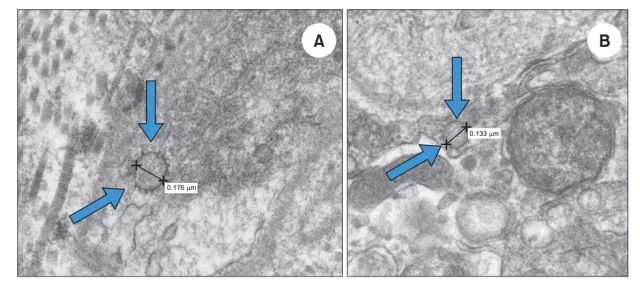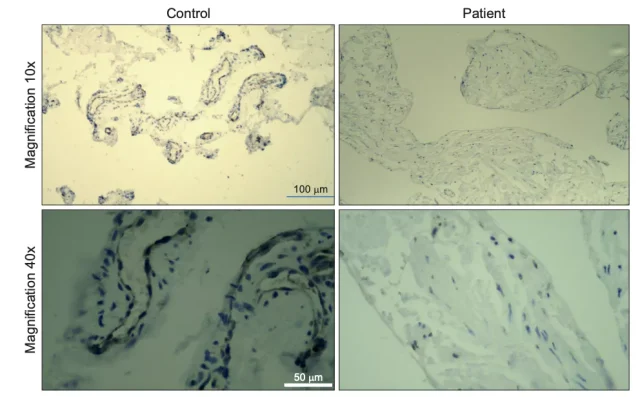COVID-19 sequalae may permanently impair male sexual function
- Normal Liver Cells Found to Promote Cancer Metastasis to the Liver
- Nearly 80% Complete Remission: Breakthrough in ADC Anti-Tumor Treatment
- Vaccination Against Common Diseases May Prevent Dementia!
- New Alzheimer’s Disease (AD) Diagnosis and Staging Criteria
- Breakthrough in Alzheimer’s Disease: New Nasal Spray Halts Cognitive Decline by Targeting Toxic Protein
- Can the Tap Water at the Paris Olympics be Drunk Directly?
COVID-19 sequalae may permanently impair male sexual function
- Should China be held legally responsible for the US’s $18 trillion COVID losses?
- CT Radiation Exposure Linked to Blood Cancer in Children and Adolescents
- FDA has mandated a top-level black box warning for all marketed CAR-T therapies
- Can people with high blood pressure eat peanuts?
- What is the difference between dopamine and dobutamine?
- How long can the patient live after heart stent surgery?
COVID-19 sequalae may permanently impair male sexual function.
New discovery of the sequelae of the COVID-19! or permanently impair male sexual function.
Recently, an unnamed man in the United States said on a show that his genitals “shrinked” 1.5 inches (about 3.8 centimeters) after contracting the new coronavirus.
According to a report by the New York Post on January 13, the man in his 30s contracted the new coronavirus in July last year and was hospitalized for treatment.
He developed genital shrinkage and erectile dysfunction problems after being discharged from the hospital.
The man said in an interview that although his erectile dysfunction gradually improved with some medical care, the length of his penis appeared to be permanently affected by the damage to blood vessels caused by the new coronavirus.
On January 13, a study by University College London in the United Kingdom showed that nearly 5% of adult men have reduced testicular and penis volume after infection with the new coronavirus, and 15% reported experienced loss of erectile function.
In 2021, a study published in the World Journal of Men’s Health explained that vascular dysfunction or endothelial dysfunction caused by new coronavirus infection may lead to erectile dysfunction (ED). Endothelial dysfunction is the inability of the lining of small blood vessels to perform all their functions properly, thus impeding blood supply to the tissue.

The researchers used microscopy to analyze the penile tissue of 2 men with a history of COVID-19 infection, and the penile tissue of 2 men without a history of infection served as a control group, imaged with TEM and H&E staining, and performed RT- PCR assays, collected tissues were analyzed for endothelial nitric oxide synthase (eNOS, a marker of endothelial function) and COVID-19 spike protein expression.
Endothelial progenitor cell (EPC) function was assessed in blood samples collected from COVID-19(+) and COVID-19(-) men.
The results showed that there were extracellular virus particles with a diameter of about 100 nanometers near the penile vascular endothelial cells of the COVID-19(+) patients, while the control group had no virus particles.
PCR showed the presence of viral RNA in COVID-19(+) specimens. The expression of eNOS in the corpus cavernosum was decreased in COVID-19(+) men compared with COVID-19(-) men. The mean EPC levels in patients with COVID-19(+) were much lower than the mean EPC in men with severe ED and no history of COVID-19.

The arrow points to the new coronavirus particles in the patient’s penis tissue

Immunohistochemistry shows endothelial dysfunction and impaired vascular integrity in penile tissue
The team also compared it to damage to lung, kidney and brain organs found in other Covid-19 patients, and said the penis may also be affected in a similar way.
The study is the first to demonstrate that the COVID-19 virus persists in the penis long after the initial human infection. The results also suggest that widespread endothelial dysfunction caused by COVID-19 infection can lead to ED.
Dr. Ranjit Ramasamy, director of the Genitourology Program at the University of Miami Miller School of Medicine and senior researcher, supported this view in an interview with foreign media, “Our research shows that the new coronavirus can cause diseases other than the lungs and kidneys.
Widespread endothelial dysfunction occurs in the organ system, affecting many organs, including the penis and testes.” He added that the team found in a study of tissue sections in men with erectile dysfunction that the symptoms may be caused by the presence of It is caused by the new coronavirus in the penis tissue, so it is necessary to be vaccinated and take protective measures.
As for the sequelae of the COVID-19, research shows that it may be far more than this.
On August 28, 2021, the top international medical journal “The Lancet” published a study showing that the vast majority of patients with COVID-19 pneumonia still have at least one of the above abnormal symptoms one year after the onset of the disease.
Among them, the proportion of women fatigue or muscle weakness is 1.43 times that of men, and the proportion of anxiety or depression is 2 times that of men.
The research was jointly completed by researchers from Capital Medical University, Chinese Academy of Medical Sciences, China-Japan Friendship Hospital, and Jinyintan Hospital. It is reported that this is the largest longitudinal cohort study of 1-year follow-up of discharged COVID-19 survivors to date.

The study included 1,276 patients with COVID-19 pneumonia who were discharged from Wuhan Jinyintan Hospital last year. The median age of the patients was 59 years, and 53% (681) were male. Some sequelae resolved significantly over time after 1 year compared to 6 months after acute infection.
The study showed that the proportion of people with at least one sequelae symptom decreased from 68% (831/1227) at 6 months to 49% (620/1272) at 12 months.
Of these, fatigue or muscle weakness was the most common symptom, but the proportion decreased from 52% (636 people) at 6 months to 20% (255 people) at 12 months. People who received corticosteroids during the acute phase of COVID-19 were 1.5 times more likely to experience fatigue or muscle weakness a year later, compared with people who did not receive corticosteroids, the study said.
Compared with the 6-month control group, the proportions of sleep disturbance, hair loss, and loss of smell dropped by nearly half, and at 12 months, they were 17% (215 people), 11% (135 people), and 4% (57 people). The proportion of palpitations and joint pain did not change significantly.
In terms of lung function, 128 discharged patients had lung CT scans at 6 months, and the results showed that all had at least one imaging abnormality. After 12 months, that fell to 84.7%.
Notably, the proportion of dyspnea patients with an mMRC score ≥1 increased slightly from 26% (313/1185) at six months to 30% (380/1271) at 12 months.
In a period of up to 12 months, about 20%-30% of moderate patients have observed pulmonary diffusion impairment (diffusion impairment, which refers to the obstacle of the physical diffusion process of O2, CO2 and other gases exchanged through the alveolar membrane). The proportion is as high as 54% in critically ill patients.
Although the main disease strain of this round of epidemic is Omicron, and many experts also say that its infection symptoms are milder than the previous strains, we still need to pay attention to protection and get vaccinated in time.
References:
1. COVID-19 Endothelial Dysfunction Can Cause Erectile Dysfunction: Histopathological, Immunohistochemical, and Ultrastructural Study of the Human Penis . https://doi.org/10.5534/wjmh.210055
2. Lixue Huang, et al. 1-year outcomes in hospital survivors with COVID-19: a longitudinal cohort study . The Lancet, 2021.
COVID-19 sequalae may permanently impair male sexual function
(source:internet, reference only)
Disclaimer of medicaltrend.org
Important Note: The information provided is for informational purposes only and should not be considered as medical advice.



